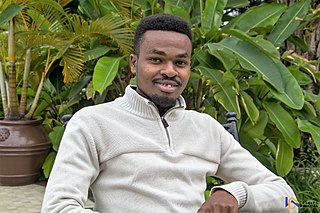Related Research Articles
The Green Belt Movement (GBM) is an indigenous grassroots organization in Kenya that empowers women through the planting of trees. It is one of the most effective and well-known grassroots organisations addressing the problem of global deforestation. Professor Wangari Maathai established the organization in 1977 under the auspices of the National Council of Women of Kenya (NCWK). GBM's successes in forest conservation, education, and women's economic empowerment have gained the organisation worldwide acclaim. It is also noted for its advocacy of human rights, democratisation of access to public lands, and environmental justice issues such as the role of women's traditional ecological knowledge in addressing environmental degradation and desertification.

Green building refers to both a structure and the application of processes that are environmentally responsible and resource-efficient throughout a building's life-cycle: from planning to design, construction, operation, maintenance, renovation, and demolition. This requires close cooperation of the contractor, the architects, the engineers, and the client at all project stages. The Green Building practice expands and complements the classical building design concerns of economy, utility, durability, and comfort. Green building also refers to saving resources to the maximum extent, including energy saving, land saving, water saving, material saving, etc., during the whole life cycle of the building, protecting the environment and reducing pollution, providing people with healthy, comfortable and efficient use of space, and being in harmony with nature Buildings that live in harmony. Green building technology focuses on low consumption, high efficiency, economy, environmental protection, integration and optimization.’

The Climate Group is a non-profit organisation that works with businesses and government leaders around the world to address climate change. The Group has programmes focusing on renewable energy and reducing greenhouse gas emissions. Launched in 2004, the organisation operates globally with offices in the UK (headquarters), the United States and India.

Environmental education (EE) refers to organized efforts to teach how natural environments function, and particularly, how human beings can manage behavior and ecosystems to live sustainably. It is a multi-disciplinary field integrating disciplines such as biology, chemistry, physics, ecology, earth science, atmospheric science, mathematics, and geography.

The Chicago Botanic Garden is a 385-acre (156 ha) living plant museum situated on nine islands in the Cook County Forest Preserves. It features 27 display gardens and five natural habitats including Mary Mix McDonald Woods, Barbara Brown Nature Reserve, Dixon Prairie, the Skokie River Corridor, and the Lakes and Shorelines. The garden is open every day of the year. An admission fee has been approved to start in 2022, not to exceed $35.

Eco-Schools is an international programme of the Foundation for Environmental Education (FEE) that aims to “empower students to be the change our sustainable world needs by engaging them in fun, action-orientated, and socially responsible learning.”

The sustainable city, eco-city, or green city is a city designed with consideration for social, economic, environmental impact, and resilient habitat for existing populations, without compromising the ability of future generations to experience the same. The UN Sustainable Development Goal 11 defines sustainable cities as those that are dedicated to achieving green sustainability, social sustainability and economic sustainability. They are committed to doing so by enabling opportunities for all through a design focused on inclusivity as well as maintaining a sustainable economic growth. The focus also includes minimizing required inputs of energy, water, and food, and drastically reducing waste, output of heat, air pollution – CO2, methane, and water pollution. Richard Register, a visual artist, first coined the term ecocity in his 1987 book Ecocity Berkeley: Building Cities for a Healthy Future, where he offers innovative city planning solutions that would work anywhere. Other leading figures who envisioned sustainable cities are architect Paul F Downton, who later founded the company Ecopolis Pty Ltd, as well as authors Timothy Beatley and Steffen Lehmann, who have written extensively on the subject. The field of industrial ecology is sometimes used in planning these cities.

C40 Cities Climate Leadership Group is a group of 96 cities around the world that represents one twelfth of the world's population and one quarter of the global economy. Created and led by cities, C40 is focused on fighting the climate crisis and driving urban action that reduces greenhouse gas emissions and climate risks, while increasing the health, wellbeing and economic opportunities of urban residents.

The Alliance to Save Energy is a bipartisan, nonprofit coalition of business, government, environmental, and consumer groups based in Washington, D.C. The Alliance states that it advocates for "energy-efficiency policies that minimize costs to society and individual consumers, and that lessen greenhouse gas emissions and their impact on the global climate." The Alliance's chief activities include public relations, research, and lobbying to change U.S. energy policy.
PlaNYC was a strategic plan released by New York City Mayor Michael Bloomberg in 2007 to prepare the city for one million more residents, strengthen the economy, combat climate change, and enhance the quality of life for all New Yorkers. The plan brought together over 25 City agencies to work toward the vision of a greener, greater New York and significant progress was made towards the long-term goals over the following years.
This article includes information about environmental groups and resourcesthat serve K–12 schools in the United States and internationally. The entries in this article are for broad-scope organizations that serve at least one state or similar regions.
The California Sustainability Alliance is an organization funded by the California IOUs, to facilitate discussions between various industries on the issues of resource sustainability. The Alliance was set up in 2008 to help California meet its goals in facing Climate change in the State, in relation to energy, resources, and the environment. Efforts are directed at increasing and accelerating sustainable measures and strategies. The Alliance specifically focuses on energy efficiency, climate action, “smart growth” principles, renewable energy development, water-use efficiency, waste management, and transportation management within California.
Marstel-Day, LLC is a natural resource and environmental consulting firm that provides management, planning, and analytical services. Headquartered in Fredericksburg, VA, Marstel-Day operates in locations including California and Texas. The firm has an 80-member, multidisciplinary team of scientists, policy strategists, planners, natural and cultural resource experts, analysts, engineers, and geographic information system (GIS) specialists. Marstel-Day LLC is led by Dr. Sean Donahoe, CEO.
A sustainability organization is (1) an organized group of people that aims to advance sustainability and/or (2) those actions of organizing something sustainably. Unlike many business organizations, sustainability organizations are not limited to implementing sustainability strategies which provide them with economic and cultural benefits attained through environmental responsibility. For sustainability organizations, sustainability can also be an end in itself without further justifications.

"Sustainability," was defined as “development which implies meeting the needs of the present without compromising the ability of future generations to meet their own needs”as defined by the 1983 Brundtland Commission. As sustainability gains support and momentum worldwide, universities across the United States have expanded initiatives towards more sustainable campuses, commitments, academic offerings, and student engagement.
The C40 Cities Climate Leadership Group’s Climate Positive Development Program (Climate Positive) was launched in May 2009 in partnership with the Clinton Climate Initiative and the U.S. Green Building Council. The program brings together leading district-scale new-build and regeneration projects working to achieve "Climate Positive"—or net carbon negative—outcomes in cities around the world. As part of the C40’s Sustainable Communities Initiative, it aims to create a model for large-scale urban communities and to support projects that serve as urban laboratories for cities seeking to grow in ways that are environmentally sustainable, climate resilient, and economically viable.
Aytzim, formerly the Green Zionist Alliance (GZA), is a New York-based Jewish environmental organization that is a U.S.-registered 501(c)(3) tax-deductible nonprofit charity. A grassroots all-volunteer organization, Aytzim is active in the United States, Canada and Israel. The organization is a former member of the American Zionist Movement and has worked in partnership with Ameinu, the Coalition on the Environment and Jewish Life (COEJL), Hazon, Interfaith Moral Action on Climate, Interfaith Oceans, GreenFaith, Mercaz/Masorti, the National Religious Coalition on Creation Care, and the Jewish National Fund (JNF)—although Aytzim has long criticized JNF for not prioritizing sustainability and environmental justice in its actions. Aytzim's work at the nexus of Judaism, environmentalism and Zionism has courted controversy from both Jewish and non-Jewish groups.

Climate change education (CCE) is education that aims to address and develop effective responses to climate change. It helps learners understand the causes and consequences of climate change, prepares them to live with the impacts of climate change and empowers learners to take appropriate actions to adopt more sustainable lifestyles. Climate change and climate change education are global challenges that can be anchored in the curriculum in order to provide local learning and widen up mindset shits on how climate change can be mitigated. In such as case CCE is more than climate change literacy but understanding ways of dealing with climate

Kaluki Paul Mutuku is a Kenyan climate activist and environmentalist, working to improve youth participation in decision-making around climate justice. He is the co-founder of Kenya Environmental Activists Network (KEAN); KEAN is a NGO that provides a platform that will bring together environmental activists. His center of attention for Africa lies around environmental rejuvenation, afforestation, organic farming and youth leadership across boards.
References
- ↑ Mounce Stancil, Joanna (26 August 2015). "Student Climate and Conservation Congress: Bright Young Minds". U.S.Forest Service. Retrieved August 26, 2015.
- ↑ Bidwell, Allie (5 December 2014). "Obama Wants Kids to Learn About Global Warming.Read more: The administration wants students and teachers to toe the line on climate change". U.S. News & World Report. Retrieved 3 December 2014.
- ↑ Kaye, Leon (14 June 2012). "Mayor Bloomberg Turns on NYC's First Wind Turbine at a City School". Inhabitat New York City. Retrieved 28 April 2014.
- ↑ New York City Department of Education (13 January 2010). "Schools Facilities CEO John Shea, City Sustainability Deputy Director Adam Freed and Actor Matthew Modine Call on Schools to Reduce Energy Consumption by Joining the Green Cup Challenge". Highbeam.com. Retrieved 29 April 2014.
- ↑ Lauren, Roth (22 April 2014). "Orange schools recognize Earth Day with green initiatives". Orlando Sentinel. Retrieved 28 April 2014.[ permanent dead link ]
- ↑ Perryfirst=Katy (3 May 2013). "How schools across the US united to save 2.5M pounds of CO2". Greenbiz.com. Retrieved 9 May 2015.
- ↑ "Large School Districts Come Together to Prioritize Sustainability - ED.gov Blog". ED.gov Blog. 2016-01-26. Retrieved 2017-07-12.
- ↑ "An alliance of superheroes from schools seek green strategies (podcast)". Lincoln Public Schools. Archived from the original on 2016-03-16.
- ↑ Peter, Gow (9 August 2013). "Public Purpose: Environmentalism in Independent Schools--and Others!". Education Week. Retrieved 21 April 2014.
- ↑ Watson, Rob (30 June 2011). "Radical Confidence in the Next Green Generation". Greenbiz.com. Retrieved 29 April 2014.